Black Rule: Stories from the New South Africa, 1994-1999
Chris Roberts, American Renaissance, April 27, 2020
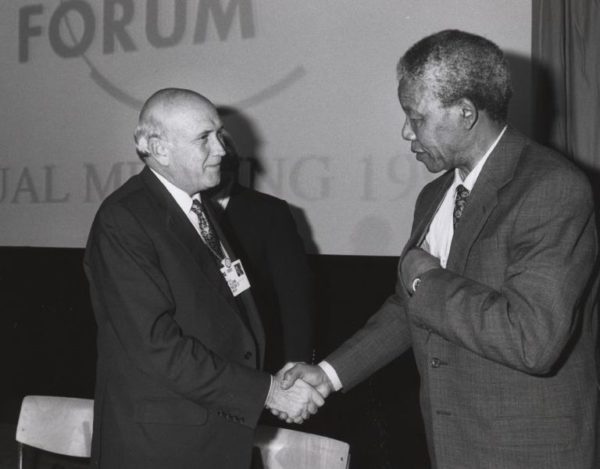
Frederik de Klerk, the last white President of South Africa, and Nelson Mandela, the first black President of South Africa. (Photo Credit: World Economic Forum)
White liberals and non-whites all around the world welcomed the transfer of power to blacks in 1994. This is a timeline of events drawn from international news stories and the American Renaissance archive.
The end of white rule in South Africa seems to have brought a new kind of violent protest: witch burning. Since the April election, hundreds, perhaps thousands of accused witches have been hunted down and killed, most often by necklacing.
In one case, a man was forced by a mob to burn his own wife to death in front of his two children. Two days later, the mob came back and burned him. They then stoned and tortured his daughter before burning her, then caught the son and killed him, too.
South Africa has always had witches and witchcraft, but the traditional remedy was to hire a nyanga, or good witch, to counter a bad witch. Suspected witches might be banished from a village, but lynchings were rare. Now, executions have taken on the trappings of the “liberation” movement. The killing is often preceded by a chanted toyi-toyi, the anti-Apartheid war dance, and burning with gasoline-filled tires was a torture designed for political enemies. Also, the leaders of today’s lynch mobs are not village elders but young “comrades” who cut their teeth on “revolution.”
Chief Agnes Moloto who runs a major chieftanship in Northern Sotho blames the killings on “the sheer ungovernability of the young.” She has braved the fury of her subjects by establishing a sanctuary for accused witches, where 20 families have already been resettled. [Bill Keller, Apartheid’s Grisly aftermath: ‘witch burning,’ NYT, 9/18/94.]
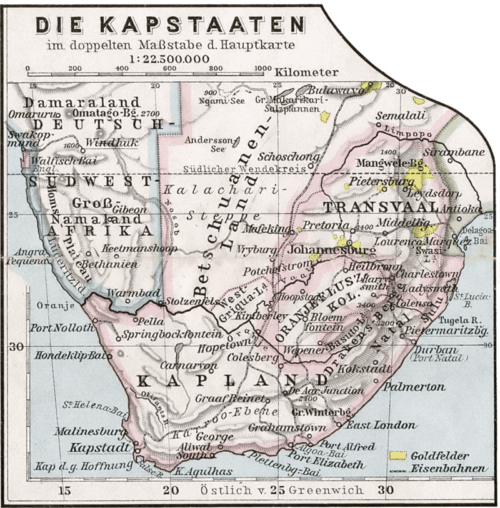
South Africa circa 1905
Even before the latest South African elections, the abolition of housing laws permitted blacks to move into previously all-white neighborhoods. Predictably, whites have been moving out. One reason is that blacks have a practice of propitiating their ancestors by slaughtering an animal on the driveway of their new home — often a sheep, goat or cow. When white neighbors call the Society for the Prevention of Cruelty to Animals they learn that driveway sacrifices are protected religious practices.
One black, noting that he briefly had white neighbors, says “They seem to be disappearing. I don’t know where they are going. But there are more of us than of them. Wherever they disappear, we will be there, too.” [Isabel Wilkerson, The suburbs of Johannesburg stay cold to blacks, NYT, 11/3/94.]
The demise of white rule has brought some rarely publicized changes to the moral tone of South Africa. The white regime was so closely associated with the Dutch Reformed Church that the latter was often called the National Party at prayer. Christianity underlay the government’s strict bans on pornography, prostitution, and homosexuality.
The new, black regime has cast all this aside. Streetwalkers now openly ply their trade, “swingers” clubs have opened, hard pornography is on sale, and homosexuality is sympathetically portrayed on national television. South Africa could become the first nation on earth to legalize homosexual marriage. [Bill Keller, Apartheid’s Gone, and anything goes, NYT, 12/28/94, p. A7.]
The country is also on a name-changing binge. The names of Jan Smuts and Hendrik Verwoerd have disappeared from streets, airports, schools, and buildings. World-famous Kruger National Park is likely to be renamed, and the names of whites were recently removed from 12 dams and waterworks. The South African Broadcasting Corporation and South African Airways are reducing their use of Afrikaans. [This Week in South Africa, Nov. 29-Dec.5, 1994, p. 2.]
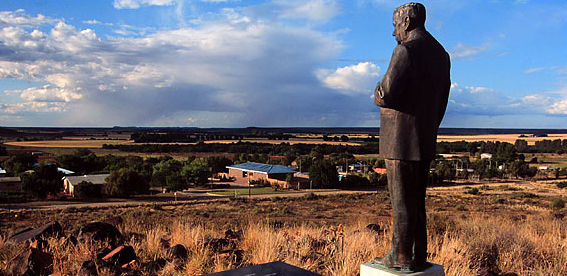
A statue of Hendrik Verwoerd, the “architect of apartheid.”
In the last years of apartheid, blacks thought that refusing to pay utility bills was a noble act of political protest. Now that the country has a black president, the noble acts continue. The government claims to be astonished by this, and has mounted a campaign to convince people to pay. “Who can be proud of not paying for housing and services now that we have a democratic government?” asks a television ad, which argues that paying rent and electric bills helps build South Africa. The utilities have even mounted traveling road shows to take the lets-pay message to people with no television, but with little success.
Slowly, the government is turning back to the bad old ways of the white man: shutting off dead-beats. Oddly, this seems to work. Not even a New York Times reporter could find much talk of building South Africa among people lined up in Soweto to pay their bills. “If they are making my lights off, then I pay,” was a typical sentiment. [Suzanne Daley, In South Africa a culture of resistance dies hard, NYT, July, 1995.]
Meanwhile, white businessmen are so desperate to get blacks on the payroll that they pay them 20 to 50 percent more than they would similarly educated whites. Many help-wanted ads are quite straightforward about seeking blacks. All this is in anticipation of affirmative action laws that have not yet been enacted, but which everyone expects to be passed soon. [Suzanne Daley, In South Africa; new jobs, little respect, NYT, Aug 3, 1995, p. A1.]
South Africa’s first black-owned bank, which flourished for 20 years under apartheid, has closed its doors. African Bank, which had mostly black customers, was dragged down by a mountain of bad debt. [S. Africa’s 1st Black-owned bank closes, Chi Sun-Times, Sept. 12, 1995, p. 30.]
Though no one quite knows why, the end of white rule in South Africa has been followed by a sharp increase in “witch” killing. Belief in witches is widespread among blacks; four fifths are estimated regularly to consult sangomas, who, though not technically witches, deal in mysterious folk medicines.
In some tribes, there is simply no such thing as an accident. Any unfortunate occurrence must have been the result of witchery. Venda tribesmen also believe in zwivhuya according to which there is only a limited amount of wealth and happiness to go around; any extra can have been accumulated only through witchcraft.
According to traditional tribal practice, when someone is suspected of witchcraft, a sangoma is called in to sniff out the culprit and then the chief determines punishment — usually banishment from the village. Lately, gangs of youngsters have stopped waiting for the chief’s sentence and summarily kill the witch. They often sing ANC “liberation” songs while they burn, beat, or stone the wretch to death. Hundreds, perhaps thousands, are killed this way every year.
In the far north of the country there is a town called Motonawabaloi, which means “place of the witches” in the Sotho language. One hundred twenty-two people live there, all of them accused witches who managed to escape mob execution but dare not return to their homes. Witch-killing is not easy to stop because so many blacks sympathize with it. “Homeland” judges often let killers off lightly.
Some sangoma remedies are indistinguishable from witchcraft. According to a traditional practice called muti, strength can be gained by drinking a stew made of human body parts. To be effective the parts must have been removed while the original owner was still alive. The penis is considered particularly potent. [Witchcraft in South Africa, Economist, Dec. 9, 1995, p. 85.]
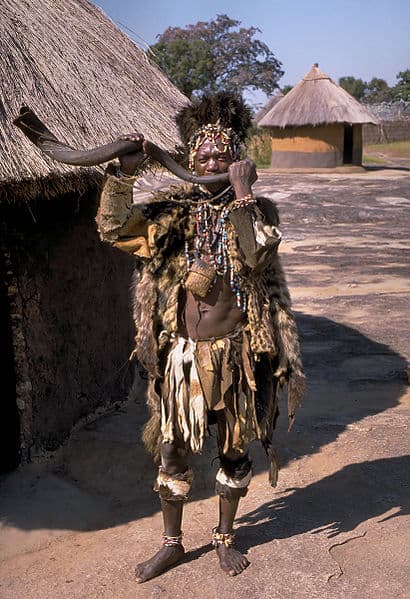
African witch doctor. (Credit Image: Hans Hillewaert)
Post-apartheid South Africa is becoming increasingly African. With the integration of schools, white children are taught at the level of blacks. Police are becoming scarce and in a single year violent crime rose 75 percent.
The number of whites fleeing South Africa has more than doubled in five years. Experts say the figures are actually higher, since many lie on their departure forms to avoid emigration restrictions. Whites who remain have converted their homes into fortresses: topping walls with razor wire and electric spikes, barring windows, and even securing bedroom doors with steel “rape gates.”
“Should I stick around and risk my children’s lives?” asks one white businessman. “You are in a constant state of limbo trying to figure this out. That’s our daily existence.” (Suzanne Daly, As Crime Soars, South African Whites Leave, New York Times, Dec. 12, 1995, p.A1.)
The faculties of South Africa’s universities are discovering that post-apartheid integration is not what activists had promised. At Witwatersrand University (“Wits”), administrators report that the school is more racially divided than ever.
Despite guaranteed tuition for passing students, 60 percent of blacks drop out, and they want more remedial help. Black students are also demanding greater influence over major administrative decisions, both for themselves and for black janitors and cafeteria workers. Many white students, formerly anti-apartheid protesters, are confused by black students’ complaints that integration is not enough.
Last spring, blacks held the registrar hostage for a day when a black cafeteria worker was fired for letting students eat without paying. The school tried to expel the students, but was forced to back down when more protests erupted. Black students could not understand why the administration thought expulsions were necessary, asking, “Why are you taking such a hard line? There was no loss of life.”
Egalitarian whites are baffled. The president of Wits wonders, “Why should we be targets now? We were targets for 40 years. Maybe we need sensitivity training, I don’t know.” (Suzanne Daley, South Africa Campuses Reap Racial Enmity, New York Times, Feb. 10, 1996, p. A1.)
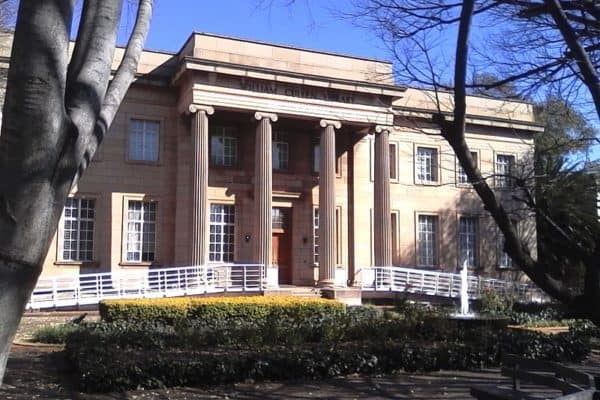
The William Cullen Library on the East Campus of the University of Witwatersrand. (Credit Image: Heather Elke / Wikimedia)
In South Africa, the ruling African National Congress (ANC) has decided to remove every painting, statue, picture, and decoration from the 110-year-old parliament building. These apartheid-era works were invariably of and by whites, and celebrated white leaders and the climactic moments of white rule. The National Assembly Speaker, an ANC activist named Frene Ginwala explained, “We will take everything down . . . to avoid the problem of what do we take down and what do we leave.”
Upwards of 7,000 items will be removed, including a giant portrait of then-Prime Minister H.F. Verwoerd outlining his plans for apartheid, and a portrait of Paul Kruger, founder of the first Afrikaner republic. For six months at least, they will be replaced by a United Nations exhibition of anti-apartheid art. No decision has yet been made on their final disposition. (Brendan Boyle, Reuters, Apartheid Pictures Come Down In S. African Parliament, Jan. 25, 1996.)
In South Africa, the government recently released a report on witchcraft, which finds that the practice is gaining adherents and is moving from the country into the cities. The report focused on the use of human ingredients in potions. In order to work, parts must be taken from live victims; the louder they scream the more potent the magic. Potions containing pieces of people are thought to cure disease, increase crop yields, and ensure misfortune for one’s enemies. A human head may be embedded in a building’s foundation to guarantee success in business.
The report, published by the Commission of Inquiry into Witchcraft Violence and Ritual Murders, warns that whites are increasingly likely to be killed for parts. Many blacks think that whites have special powers that account for their wealth, and believe that whites therefore provide the most potent human ingredients. (Inigo Gilmore, Human Parts Sold In South African Witchcraft Killings, Times (London), May 4, 1996.)
Under apartheid, Johannesburg was a pristine oasis of European civility in the heart of the dark continent. No more. Now that blacks are permitted in previously white areas, hundreds of thousands have streamed into the city. They have set up camp in parking lots and on sidewalks, hawking trinkets and spreading garbage wherever they go. Hundreds of companies have moved out of the city to the northern suburbs, where whites are fighting a rearguard action against the rising tide. Many whites now refuse to go down town. The Johannesburg Art Gallery, one of South Africa’s finest museums, has seen annual attendance drop from 150,000 to 50,000. The five-star Carlton Hotel, which was once the hub of downtown Johannesburg, has announced huge losses and has said it will close nearly 500 of its 668 rooms. Violent crime has, of course, been soaring. (Suzanne Daley, Downtown’s Denizens: Fear, and Fearless Vendors, New York Times, Aug. 21, 1996.)
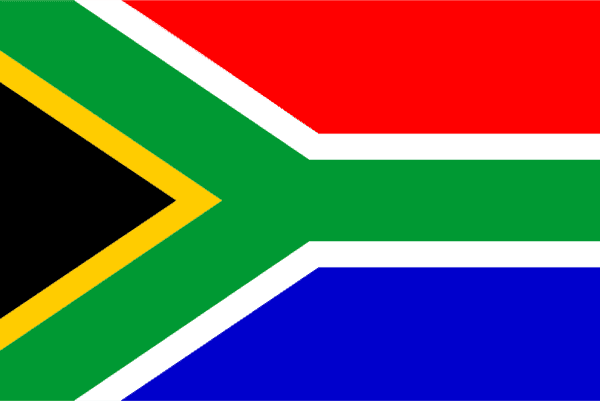
1997:
In 1997, 109 doctors left South Africa, the highest level recorded in a decade. So many have left over the last few years that the country now “imports” doctors from — of all places — Cuba. As part of a program started in 1996, 404 Cubans now work in South Africa’s rural clinics and hospitals. Some of the South African doctors who have stayed question the competence of the Cuban doctors but South African Health Ministry spokesman Vincent Hlongwane dismisses such criticism as “racism” and resentment at losing income to Cubans. (Kathy Chenault, South Africa Brain Drain Leaves Shortage of Doctors, San Francisco Examiner, November 22, 1998, p. A-20.)
There have been many news stories about the sharp rise in the number of rapes in South Africa. A recent article in a South African paper discusses a possible reason:
‘Most of the recently reported rapes have been by Black men on White women.’ The article evokes ‘the tendency of politically ascendant groups to have their way with women among those they believe they have conquered.’ ‘Black men have always regarded women as there for the taking. Now they are transferring this attitude, mingled with political triumph and apartheid-hate, to their treatment of White women . . . We may not understand why more White women are being raped by Black men but let’s not pretend it is not happening.’ (Martin Williams, The Citizen, Feb. 8, 1997.)
White South African liberals have discovered that they get no gratitude from blacks for the fight against apartheid. Helen Suzman, now 79, was one of the original white anti-white activists. “I am surprised at the hostility to liberals these days, even from moderates in the African National Congress,” she says; “I expected it from the right and the far left, who have always called us “Lenin’s useful idiots,’ but I didn’t expect it from them.”
Professor Ithumeleng Mosala explains why blacks despise liberals: “Liberalism is rooted in individualism and that is part of the problem in our society, and it is rooted in possessiveness. Instead of having a proper revolution in this country, we’ve had a liberal revolution and that is why blacks are still where they are today, in the gutter, and why whites are still rich.” Today, it is routine for whites who worked for majority rule to be called “racists” by the people they helped put into power.
Miss Suzman expects the best: “Liberals are a sort of endangered species, but as far as I am concerned we have won — look at the constitution, the bill of rights, they are everything we stood for — so let them rant. I am surprised, but I am not worried.” (Richard Meares, White Liberals Face Hostility in New South Africa, Reuters, March 17, 1997.)
In South Africa’s KwaZulu Province, teenagers with AIDS are deliberately spreading the disease so they will not be the only ones to suffer and die. Some have started raping women so as to spread the disease more quickly. Women describe being raped by laughing teenagers who tell them to relax and not to cry because “everyone has AIDS now.” As one rapist explained to researchers, “You know you’ll be rejected, you know you’re going to die. All you can do is go off and spread [AIDS]. It’s your only hope, knowing you won’t die alone.”
One doctor working in rural areas told researchers she no longer tells patients if they are HIV positive unless they ask — and they never do. “They just go out and spread it anyway,” she explains. “Even if they say they’re not, they’re lying. It’s how they cope. I don’t tell them anymore.” Many medical personnel do not even test for HIV for fear that positive results will be taken as a death sentence and a license to rape.
Suzanne Leclerc-Madlala, a lecturer at University of Durban-Westville who has been studying AIDS in the province, called the behavior “quite opposite to what AIDS educators would hope for.” (Sapa-AFP, Doomed South African Teenagers on Mission to Spread AIDS: Report, Aug. 24, 1997.)
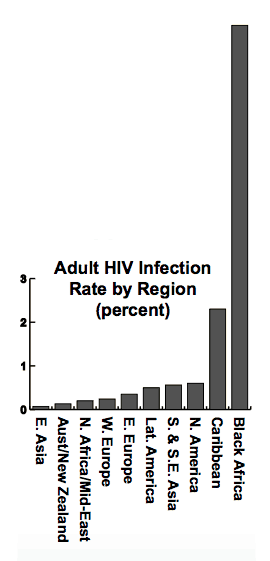
1998:
One reason South Africa is overrun with criminals is that the police can’t keep the crooks they arrest. During the last four years, 34,000 prisoners have escaped from custody. During the same period, 171 police officers were prosecuted for helping prisoners get away. (Reuters, South Africa Having Trouble Holding Inmates, Jan. 17, 1998.)
South African witch doctors, who prefer to be called sangomas, want more respect. Along with inyangas (bone throwers) and faith healers, they have formed a group called Traditional Medical Practitioners of South Africa, which tries to improve their image. Their greatest stumbling block is the fact that some traditional medical prescriptions require fresh human organs. South African authorities estimate that 200 or so people are killed every year for parts.
Human blood is supposed to impart vitality, hearts cure heart disease, and brains bring money and political power. Female genitals and breasts can cure infertility, and male genitals are good for an all-round pick-me-up. The going rates for organs are said to be on the order of $300 for a kidney, $600 for a heart, and $120 for a testicle, so a full cadaver can represent a substantial sum. We are unaware of whether white parts sell at a premium. (Christopher Munnion, Witchdoctors Claim Cut in Ritual Killings, Telegraph (London), Jan. 3, 1998.)
The South African lower house of parliament has passed a law that requires companies with more than 50 employees to submit affirmative action plans. The plans must explain how the companies will make their work forces reflect the racial proportions of the country. If a company does not submit a plan, or if the Labor Department doesn’t like the plan, the company will be fined.
The law does not use the word “quota,” but white legislators know where this is headed. Pieter Groenewald, a member of the Freedom Front, called the black labor minister a “racist” for supporting the bill. When Mr. Groenewald refused to take back the word “racist,” he was ejected from the chamber, to the cheers of members from the African National Congress. Constand Viljoen, leader of the Freedom Front, then walked out with all of his fellow party members.
A black government spokesman explained that the bill was necessary because of “the accumulation of wealth by the minority community based on the exploitation of cheap black labor.” Nelson Mandela says new regulations will “help eliminate decades, even centuries, of racism.” (Andrew Selsky, Law Shapes S. Africa Workforce Mix, AP, Aug. 21, 1998.)
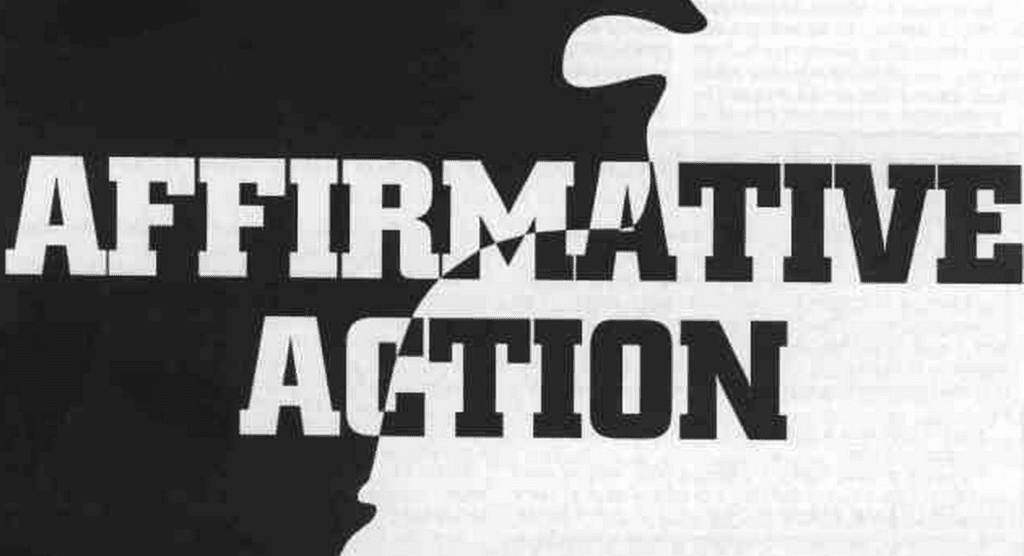
Many Africans believe that sex with a young virgin can cure everything from money problems to AIDS to a bad harvest — and the sex need not be consensual. This belief has lead to an epidemic of child rape. “It is hard to find a virgin of 16 nowadays, so men are turning to babies under 10,” says Mamelato Leopeng, an AIDS worker from South Africa.
Although child rape has come under increasing scrutiny because it has become a conduit for AIDS, it is an old practice in Africa. Witch doctors have traditionally prescribed sex with a virgin as a powerful cure for a variety of diseases and personal problems. (Dean Murphy, Africa’s Silent Shame, Los Angeles Times, August 16, 1998, p. A1.)
White liberals in the “new” South Africa find they are not appreciated by their black former comrades. Professor John Dugard was one of South Africa’s most prominent intellectuals. He is a world authority on international law and was an architect of the “progressive” post-apartheid constitution. He recently left South Africa after he was passed over for a judicial post, apparently because he is white. He now imparts liberalism to students at Leiden University in Holland.
Mandi Smallhorne was a member of “Black Sash,” a group of white women who crusaded against apartheid. She recently wrote in a Johannesburg newspaper that “in the old South Africa a significant number of people of darker hues accepted and welcomed me because of my anti-apartheid views. In the new South Africa I am treated with contempt and hatred, for no other reason than that I have white skin.” Referring to Bishop Desmond Tutu’s description of South Africa as a “rainbow nation” she says, “What kind of rainbow is it where every colour is acceptable as long as it is black?”
The stress of living under black rule is taking its toll on South Africa’s whites. A poll last month shows 74 percent of those with skilled jobs are thinking of leaving. (David Beresford, No Room in the Rainbow for Liberals, The Guardian News Service, September 17, 1998.)
One world atlas reports: ‘South Africa is the world’s most dangerous country (besides war zones), with 40,000 murders a year.’ It wasn’t this way four years ago, before the ANC took power. But the government says the murders are a ‘legacy of apartheid.’ That’s part of the problem. Everything that goes wrong is ‘a legacy of apartheid.’ The violence in the rest of Africa is a ‘legacy of colonialism.’ It’s a legacy that has gone on for almost 40 years. Every time something goes wrong (and that happens constantly), the same litany of excuses are recited. ‘We inherited this problem from the corrupt apartheid regime.’
In the northern suburbs of Johannesburg, citizens are fighting back [against crime]. In some areas they have put security guards at the entrance to a subdivision. Entrances are closed off with gates to control who comes in and who goes out. Criminals can no longer simply load their cars with stolen goods and speed out when security guards stop them at the gate. These areas have seen dramatic reductions in crime. But the ANC has ordered the gates removed. It claims these efforts force crime away from white areas and are therefore racist.
You turn on the television . . . and hope you get the right sound with the right picture. Sometimes you get the sound of one show with the picture of another. Sometimes it’s just the one or the other. Or a radio station instead of the soundtrack . . . [A] large number of the ‘old’ employees have walked out of the broadcasting studios. They couldn’t take it any more. And since television is an arm of the government, their replacements are appointed politically, not because of their experience or ability.
The hospitals in South Africa have become nightmares. Two years ago Mandela announced free medical care for children. The hospitals are now filled with unemployed women and their children. They sit there for hours to have a cough or a runny nose checked.
In America, you don’t see what’s happening. I know; I watch CNN. It doesn’t even come close to telling the truth about the decline and death of South Africa. The American media can’t tell the truth now — they have invested too much in telling everyone what a saint Mandela is. (Jim Peron, Die the Beloved Country, Liberty, Sept. 1998, p. 30.)
Black rule has been a nightmare for the farmers of South Africa. Since May, 1994, when Nelson Mandela’s government took power, there have been more than 2,000 attacks on farms resulting in 570 murders. During the first eight months of 1998 alone there were 590 attacks and 104 murders. Many of the victims died only after being raped and tortured for hours. A recent issue of the South African publication the Aida Parker Newsletter was entirely devoted to this campaign of terror that has gone virtually unreported in the United States.
Under white rule farmers were safe from violence, but in the changed psychological atmosphere of black rule they have become easy targets because many live in isolated areas. Farmers are now four times more likely to be killed than other South Africans — in a country whose post-apartheid crime wave has given it the highest murder and rape rates in the world.
The farmers who remain on the land are outraged by the attacks and by the government’s apparent lack of interest in stopping them. They suspect the killings may be part of a plan to drive whites off the land. As Aida Parker writes, “Is what we are seeing a coordinated, creeping land occupation, an Africanised quasi-nation-alisation . . . ?”
Theft is only a secondary motive in many of the killings. Sometimes the murderers take nothing at all, and even when they do take weapons or money they kill needlessly and viciously. In the somewhat tepid words of a National Intelligence Agency report, “in almost every case, the degree of violence inflicted upon the victims . . . was completely excessive and totally out of proportion with the objectives . . . The torture and rape of victims suggests that the attackers do not merely intend to kill the victims, but to inflict pain, humiliation and suffering.” It is common for bands of blacks to attack at nightfall and torture their victims until morning. Here are the details of the injuries of an Eastern Trans-vaal farmer who was tortured for six hours before he was finally killed:
- Hands tied behind the back with telephone wire
- Genitals burnt and kicked in
- Feet bound with a piece of clothing
- Finger and toenails extracted with hot pliers
- Ruptured spleen
- Weals on whole body — supposedly whip marks
- Burns on whole body — apparently applied with a hot poker
- Skull fractured and splintered at back
- Broken neck
- Skin burnt by hot coals on back
President Nelson Mandela says the killings are the random work of common criminals and dismisses outrage over the terror as the result of a “racist propaganda campaign.” The rest of the world seems to agree. As Miss Parker notes, “the outside world, in particular that ‘great citadel of democracy and freedom,’ the US, remains blind, deaf and dumb to what is happening here.” (SA’s Bloody Road to Ruin, Aida Parker Newsletter, Spring, 1998. Address: PO Box 91059, Auckland Park, 2006, South Africa)
1999:
Sibusiso Madubela was a captain in the Azanian Peoples Liberation Army during the fight against apartheid in South Africa. In 1994, when the country was handed over to the ANC, he joined the South African Defense Force but his rank was reduced to lieutenant, a demotion he considered “racist.” Earlier this year, he was granted leave from the Tempe military base in Bloemfontein to bury his father, but he overstayed his leave by ten days and had his pay docked. On September 16th he asked to see the base commander to complain about the punishment but the commander was elsewhere. Lieutenant Madubela then checked out his weapon and went on a shooting rampage, killing six white officers and a white woman civilian. He is reported to have pushed blacks out of the way in order to get clear shots at whites. He also managed to wound five people — all white — before he was shot and killed by one of the whites he wounded. Siphiwe Nyanda, chief of the South African Defense Force, insisted that it would be a mistake to assume that the shootings were racially motivated.
Lieutenant Madubela’s funeral attracted an estimated 2,000 mourners. The Pan-Africanist Congress (PAC), which still lingers on from anti-apartheid days, was furious that the army did not give him a military burial and vowed it would fire its own 12-gun salute. As people arrived at the burial ground, police confiscated weapons while blacks chanted “one settler [one white], one bullet.” In the funeral oration a PAC official vowed that his group would carry on Mr. Madubela’s good work and that the lieutenant had gone on his heroic rampage in order to “teach whites a lesson.” PAC members then began to fire a salute but were stopped by police who fired their own weapons into the air. At least three people were hurt in the panic that followed.
The funerals of the white officers were calmer but not without tension. Some black soldiers reportedly refused to join the honor guard, and blacks from other units are said to have been rounded up to fill out the ranks.
The integration of black “liberation” fighters into the South African army has not gone smoothly. The Tempe base was one of the first at which it was attempted, and the result has been continuous racial tension in an army in which most of the high-ranking officers are still white. British experts called in to help with integration warned two years ago that there was much hostility, calling Tempe “a racial powder keg waiting to explode.” (AP, S. African Shooter Had Been AWOL, Sept. 17, 1999. Black Lieutenant Kills 6 White Officers, Civilian, Washington Times, Sept. 18, 1999, p. A5. Elise Mnyandu, Race Tension Mars Burial of White S. African Troops, Reuters, Sept. 22, 1999. Michel Muller, Police Shoot at S. African Funeral, AP, Oct. 2, 1999.)
Johannesburg, South Africa’s largest city and industrial hub, is now known as the “rape capital” of the world. A recent poll of 4,000 Johannesburg women found that an astonishing one in three had been raped in the preceding year. In a related survey, a quarter of a sample of 1,500 Soweto school boys said “jackrolling” — the South African term for recreational gang rape — is “fun.” The vast majority were unaware that condoms help protect against AIDS.
Occasionally rapists are caught and prosecuted. In January, the first black to play on South Africa’s national cricket team, Makhaya Ntini, appeared in court on rape charges — to the dismay of those who have been touting him as a role model. (South Africa’s Rape Shock, BBC News, Jan. 19, 1999.)
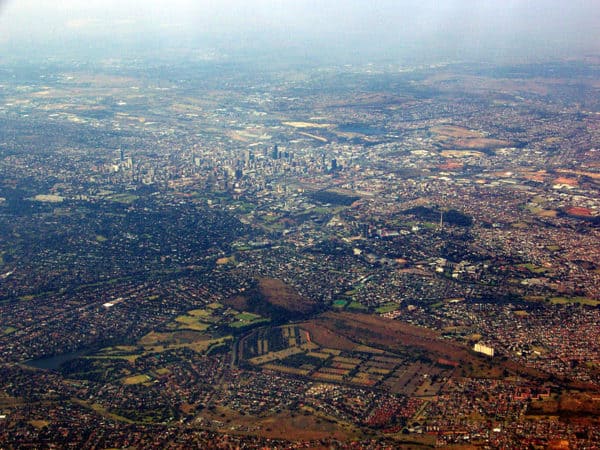
Johannesburg, South Africa. (Credit Image: Andres de Wet / Wikimedia)
The United Cricket Board of South Africa has decided that the game is too white. During a two-day development conference in May, the board decided that the entire sport — players, umpires, administration — must be 50 percent black in three years. The goal is to achieve a 25 percent representation in the first year, 40 percent the next, and 50 percent in the third year. That is supposed to set in motion trends that will eventually lead to the sport becoming dominated by blacks in proportion to their percentage in the South African population. Beginning immediately, provinces are forbidden to field all-white teams in senior competitions. (Rodney Hartman, Cricket “Must Have 50-50 Racial Split,’ Sunday Times (London), May 30, 1999.)
The June issue of Reason magazine reports that the murder rate of 63 per 100,000 is now nine times that of the United States and that for white farmers — who have been systematically targeted — the rate is a staggering 120. The same article notes that the police absenteeism rate is about 30 percent a day, and that in 1997 14 percent of the national police force were charged with crimes.
The article continues: “To make matters worse, President Nelson Mandela celebrated his 80th birthday last year by releasing 9,000 criminals early. The next day two of them murdered an elderly couple. Another released convict, who had been imprisoned for raping a 50-year-old woman and then hacking her to death, promptly tied up and raped his two nieces, 13 and 14, and went onto rape at least five other children.”
Elsewhere, the article notes the sharp increase in carjackings and observes: “One ANC official denied there had been a real increase in hijackings, claiming that “whites’ were making fraudulent reports to collect insurance payments. Another official blamed the hijackings on what he described as the apartheid government’s policy of giving hijackers immunity from prosecution. He didn’t explain how a government that has been out of power for five years could give immunity to people committing carjackings now.” (Jim Peron, Crime Stoppers, Reason, June, 1999, p. 56.)
Unto Dust is an early South African anti-racist novel written by Herman Charles Bosman, who died in 1951. Chris Roos, a white school teacher in Pretoria lost his job when he assigned it to his sixth-grade students because it uses the word “kaffir,” which is the South African equivalent of “nigger.” Black parents whooped, and Roos got the sack. A black spokesman for the provincial Education Department, Aubrey Matshiqi, explained that “the story has a very powerful anti-racist message; I am convinced the teacher’s intentions were noble.” However, he also thought Mr. Roos should be fired, because “our schools are still trying to grapple with race issues.” (Andrew Selsky, Story Prompts Teacher’s Dismissal, AP, June 23, 1999.)
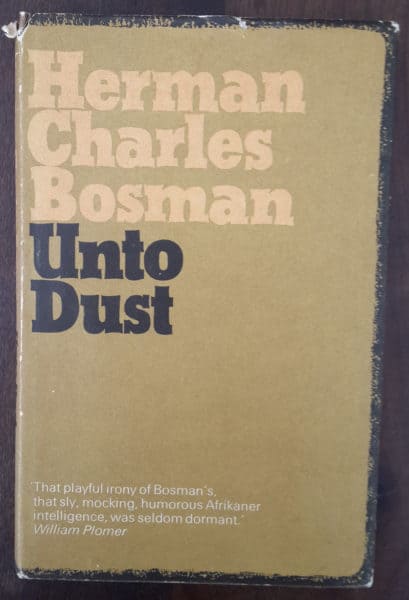
What was supposed to be a shining example of black empowerment in South Africa has come to a humiliating end. New Africa Investments, Ltd., which was established as a major black-owned insurer in 1993, has responded to an investor revolt and will restructure in a way that ends black ownership.
The company was founded just before the 1994 elections that brought the ANC to power. The South Africa Life Insurance company decided it would curry favor with the new rulers-to-be by spinning off 30 percent of Metropolitan Life, its subsidiary that wrote policies for blacks, and turning it over to black control. It larded the board of directors with ANC favorites and appointed as chairman Nthato Motlana, an old friend and personal doctor of Nelson Mandela. Although the directors owned a minority of the stock, theirs were the only voting shares, while white-owned companies and investors held the far larger number of non-voting shares — a dual control system rather like apartheid in reverse.
The company has gone downhill, with its stock losing half its value since early 1998. Nothing daunted, the black directors decided to vote themselves $20 million worth of stock options and to dilute the non-voting shareholders further by increasing the number of that class of stock by 50 percent. In April, outraged non-voting stockholders finally forced the directors to reorganize the company along conventional lines and let all investors vote their shares. Dr. Motlana has resigned as chairman, and whites will pick up the pieces.
This is only the latest “black empowerment” scheme to go south. The 100-year-old mining house JCI, Ltd. was broken up after its black chairman, Mzilikazi Khumalo, was booted for insider-trading. Another conglomerate is still headed by Cyril Ramaphosa, a former General Secretary of the ANC, but it no longer tries to run anything; it just holds shares in other companies. (Donald G. McNeil, Major Black Empowerment Company Restructures, Returning Control to Whites, New York Times, Aug. 6, 1999.)
Roger Russel of South African started out on a marathon walk from Cape Town to Johannesburg and back to call attention to his country’s frightening crime rates. Just 12 miles into his walk he was robbed at gunpoint of everything except the clothes he was wearing. (Reuters, Crime Awareness Activist Gets Mugged, Aug. 25, 1999.)
South Africa has what is probably the highest rape rate in the world. In 1998 there were 115.8 reported rapes per 100,000 people (and many unreported) compared with 34.1 rapes per 100,000 in the United States. South Africans now get almost daily accounts of rapes including “jack-rollings” in which a mob seals off an entire street or building and gang-rapes every woman it can catch. South African men think they are more or less entitled to a woman’s favors. A survey found that 12 percent of teenage boys admitted to having forced themselves on someone, and half said that a girl who says no really means yes. Thirty-one percent of boys who knew a rape victim said she had been asking for it. One in three Johannesburg schoolgirls said they had been raped but only one in eight realized it was illegal.
Since about 13 percent of South African adults are infected with AIDS, the attacks can be a death sentence. Some men rape women in the hope of spreading the disease, and others rape children in the belief that sex with a virgin cures it. Cape Town’s Red Cross War Memorial Children’s Hospital reports about 10 cases of child rape every week; recently a six-month-old baby was raped to death. Only one in 400 rapes leads to a conviction.
There has been something of an anti-rape campaign, which was to include a commercial by actress Charlize Theron. In it, she says: “People often ask me what the men are like in South Africa. Well, consider that more women are raped in South Africa than any other country in the world. That one out of three women will be raped in their lifetime in South Africa . . . It’s not that easy to say what men in South Africa are like, because there seem to be so few out there.”
The Advertising Standards Authority banned the ad because it discriminated against men. It is into this market that CGU Insurance, Ltd. has introduced rape insurance — the first offered anywhere in the world. For about $4 a month, the policy will cover psychological and medical treatment, as well as the expensive anti-AIDS drugs not offered by government health services. (Andrew Maykuth, In Rape-Scarred Nation, an Insurance Plan, Philadelphia Inquirer, October 16, 1999, p. A1.)
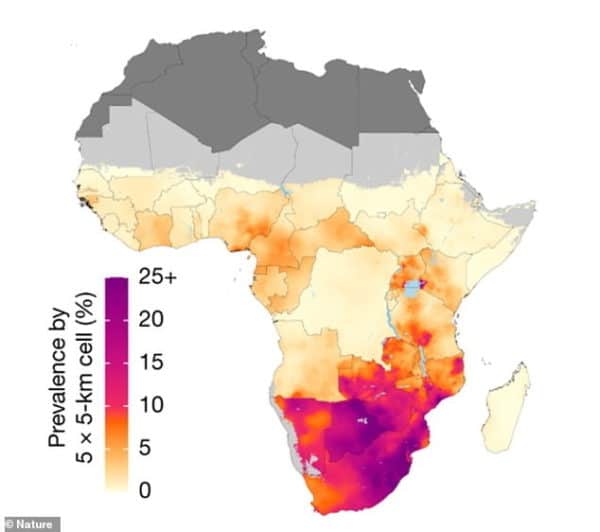
HIV rates in Africa.
Skilled South African whites are clearing out as racial preferences get worse, and many are going to Australia. “Youngsters are saying they can’t get a job unless they’re black,” says a Perth employment agent. “Unfortunately it [affirmative action] seems to be creating a new generation of racists.” Initially it was mostly Anglo-South Africans who made the “chicken run” (escaping black rule) but now Afrikaners and even Indians are leaving. In the year ending June, 1999, Australia granted 5,704 “skill stream” visas to South Africans who were let in to improve the workforce. It also admitted 850 South African entrepreneurs who must invest between three and eight million rand ($500,00 to $1.33 million) in new businesses. Many South Africans who have stayed are hedging their bets by sending their children to college in Australia. (Lindsey Arkley, Affirmative Action Behind Chicken Run, The Sunday Independent (South Africa), December 11, 1999.)
Because so many young whites are leaving, old people face their final years alone. “It is horrible here at Christmas,” says retired school principal Dawn Darby. Mrs. Darby was upset when her children left but now realizes it is for the best. “This is no place to bring up children. The standard of schooling is definitely dropping . . . I think it’s going to get worse here.” (Anton La-Guardia, Elderly Whites Face Life Alone, Washington Times, December 30, 1999, p. A16.)
Please be on the lookout for updates to this timeline as we follow South Africa into the present.
















